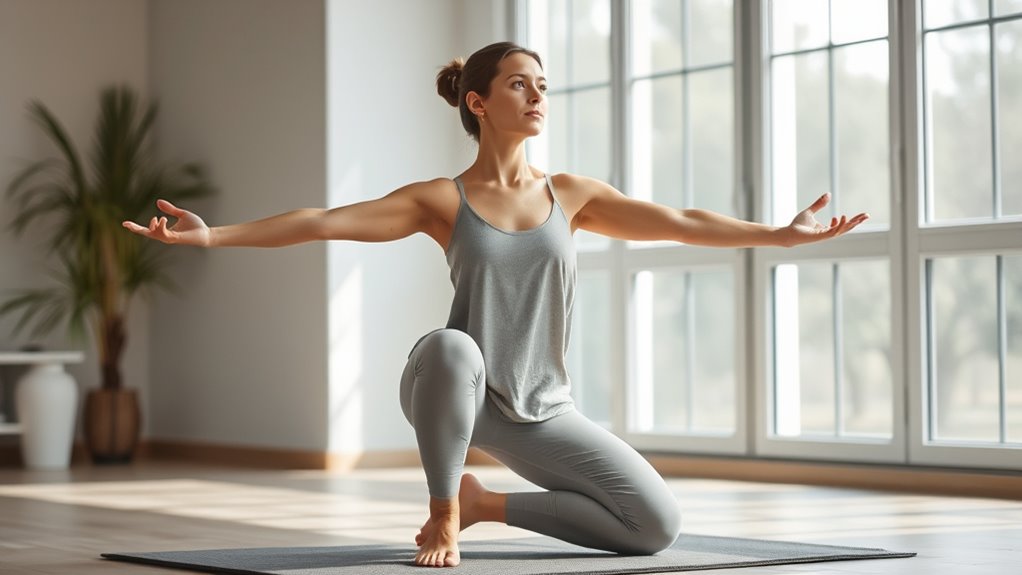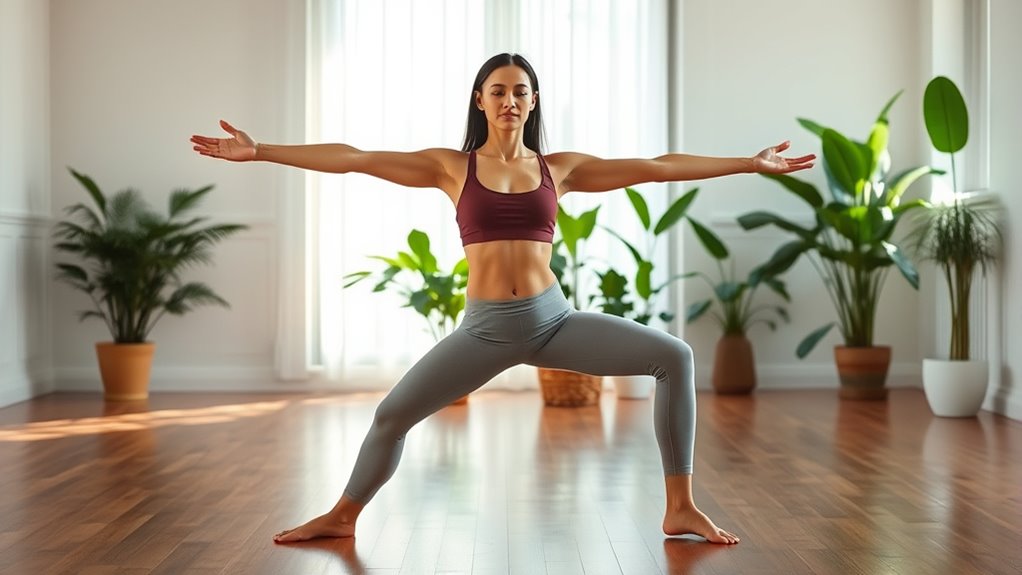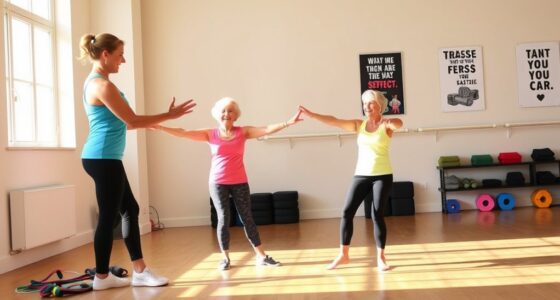To ease joint pain and boost your balance, try gentle poses like Cat-Cow to improve comfort and flexibility. Focus on calming your nervous system with mindful breathing, keeping your spine straight and shoulders relaxed. Tree Pose helps enhance stability by engaging your core and maintaining steady breath. Using proper alignment and controlled movements, you’ll support joint health while cultivating strength and balance. Keep exploring these practices further to discover more ways to feel better in your body.
Key Takeaways
- Gentle poses like Cat-Cow promote joint lubrication and flexibility while minimizing strain.
- Balance-focused poses such as Tree Pose enhance stability and strengthen supporting muscles.
- Maintaining proper posture alignment distributes joint stress evenly, reducing pain and discomfort.
- Deep, meditative breathing calms the nervous system, decreasing pain perception and joint tension.
- Slow, controlled transitions between poses prevent joint strain and improve overall joint comfort.

If you’re dealing with joint pain or struggling to maintain your balance, practicing specific yoga poses can offer relief and stability. One of the key elements in these poses is focusing on meditative breathing, which helps calm your nervous system and reduces pain perception. As you breathe deeply and steadily, you’ll notice a decrease in tension around your joints, making movement more comfortable. Pairing this with proper posture alignment ensures that you’re distributing your weight evenly and avoiding unnecessary strain. When your posture is aligned correctly, your joints work more efficiently, reducing discomfort and preventing further issues.
Begin by finding a comfortable seated position, where you can focus on meditative breathing. Inhale slowly through your nose, filling your lungs, then exhale gently through your mouth or nose. As you do this, be mindful of your posture—keep your shoulders relaxed, your chest open, and your spine straight. This focus on posture alignment is fundamental because it sets the foundation for safe and effective yoga practice. When your spine is aligned properly, your joints are less stressed, and you can move through poses with greater ease. This mindfulness in breathing and posture helps you stay present, reducing the tendency to push beyond your limits.
Find a comfortable seated position, focus on breathing, and align your spine for safe, effective yoga practice.
Moving into gentle poses like the Cat-Cow stretch can further improve joint comfort and balance. As you transition between these poses, pay attention to your breath, inhaling as you arch your back and lifting your tailbone, then exhaling as you round your spine. Keep your movements slow and controlled, maintaining awareness of your posture and breathing. This not only relieves tension but also promotes better joint lubrication and flexibility. Additionally, incorporating exercises that support proper color accuracy can help enhance your overall sense of balance and coordination, which is vital for those with joint issues.
Another effective pose is the Tree Pose, which enhances balance and stability. Stand with your feet hip-width apart, then shift your weight onto one leg. Place the sole of your other foot against your inner thigh or calf, avoiding the knee joint. Focus on meditative breathing to anchor your attention and keep your gaze steady. Throughout, ensure your hips remain level and your spine stays upright—good posture alignment here is essential. As you hold the pose, your core engages naturally, supporting your joints and improving overall stability.
Frequently Asked Questions
Can Beginners Safely Do These Yoga Poses?
You can definitely do these yoga poses safely as a beginner. Start with modifications for beginners to make poses more comfortable and avoid strain. As you gain confidence, you can explore advanced pose options to deepen your practice. Always listen to your body, and consider working with an instructor who can guide you through proper alignment and modifications. With patience and proper guidance, you’ll build strength and flexibility safely.
How Often Should I Practice for Joint Pain Relief?
Did you know that practicing yoga just three times a week can considerably reduce joint pain? For relief, follow general frequency guidelines, but remember, personalized routines work best. You should aim for consistent practice, about 2-4 times weekly, adjusting based on how your body responds. Listen to your body and consult a healthcare professional to develop a safe, effective routine tailored to your needs.
Are There Any Poses to Avoid With Severe Arthritis?
You should avoid inappropriate poses that could cause joint strain if you have severe arthritis. Poses that involve deep bending, twisting, or putting excessive weight on joints might worsen your condition. Instead, focus on gentle stretches and supported poses. Always listen to your body and consult your healthcare provider or a certified yoga instructor to tailor practices that help your joints without risking further damage.
How Long Does It Take to See Improvements?
Think of your progress like planting a garden; it takes time to see blooms. Usually, you might notice improvements in joint pain and balance within 3 to 6 weeks of regular practice. Incorporate mindfulness meditation and breathing exercises to enhance results. Consistency is key—just as watering plants regularly helps them flourish, daily practice helps your body adapt and improve gradually.
Can Yoga Replace Physical Therapy for Joint Issues?
You might wonder if yoga can substitute physical therapy for joint issues. While yoga offers beneficial complementary therapies and helps improve flexibility and balance, it shouldn’t replace professional guidance. Exercise modifications in yoga can support your recovery, but consulting your healthcare provider ensures you’re doing what’s safe. Combining yoga with traditional treatments can enhance your overall progress, yet personalized care remains essential for effective joint health management.
Conclusion
By incorporating these yoga poses into your routine, you’re planting seeds of strength and flexibility that grow stronger with each practice. Think of your joints as delicate flowers that blossom with gentle care, and your balance as a sturdy tree rooted in stability. With patience and consistency, you’ll watch pain fade like morning fog, revealing a vibrant, steady foundation beneath. Keep nurturing your body’s garden, and watch your well-being flourish like a bright, unstoppable sunrise.








